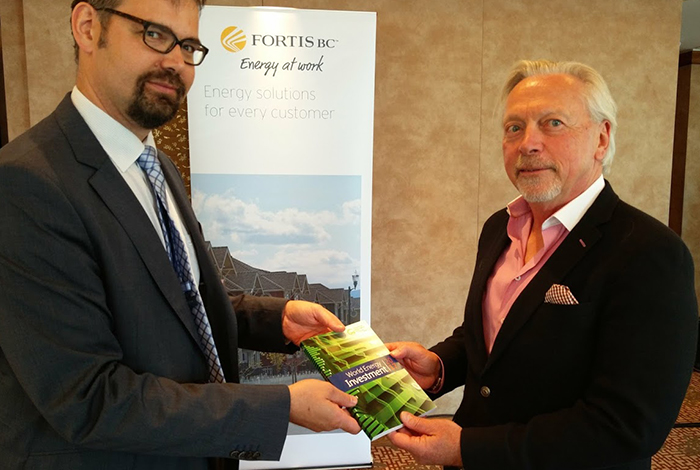A low carbon future runs through existing infrastructure
September 19, 2017
Discussion and engagement is critical to define and build the energy future we want. That’s why, this summer, FortisBC hosted its first Energy Leadership Forum to discuss the future of the energy sector and the implications to British Columbia. The Forum heard from Laszlo Varro, Chief Economist of the International Energy Agency (IEA) to provide a global perspective on investment trends in the energy sector.
Varro opened by highlighting that in 2016, investment in renewable power was more than twice that of investment in coal and natural gas generation. The number of electric vehicles on the road grew by 40 per cent and investment in energy efficiency grew by nine per cent - outpacing growth in any other source of energy supply. It is no coincidence that amid ongoing economic growth, global greenhouse gas (GHG) emissions flattened for three straight years - the first time this has happened in the post-war era.
“But it is still much too early to declare victory against climate change,” said Varro. “Advancements in clean energy are significant but they still exist at the margin of the global energy system. The real challenge is in addressing our existing infrastructure and the long history of investment decisions that are energizing the bulk of our modern economy.”
To understand how existing infrastructure complicates GHG reductions, consider the buildings sector, responsible for 29 per cent of global GHG emissions. The vast majority of the buildings consuming energy in 2030 and 2050 (when Canada and BC have set their GHG reduction targets) have already been built. Energy efficient retrofits in buildings will play an important role to reduce their carbon intensity. But, retrofitting all of this infrastructure would be a truly ambitious project requiring significant levels of investment and stringent policies.
When it comes to managing and renewing energy infrastructure, FortisBC is an expert. We own and operate over 47,000 kilometers of pipelines and 7,200 km of power lines. Last year, FortisBC invested over $333 million in capital projects to provide safe, reliable affordable energy for consumers across BC. Achieving our GHG reduction commitments in the Paris Agreement must leverage this infrastructure to ensure affordability for BC ratepayers. Varro stated that some countries in Europe are recognizing the scale of the retrofit challenge and are looking to innovative approaches to develop clean fuels for buildings that utilize existing gas line infrastructure rather than replacing and renewing the entire building stock.
FortisBC has been a leader in Canada in developing carbon neutral fuels like Renewable Natural Gas and innovative approaches to reduce the carbon intensity of difficult sectors like marine shipping. FortisBC can leverage its existing infrastructure to deliver Renewable Natural Gas to any natural gas customer in BC who wants to purchase it. At FortisBC’s Tilbury liquefied natural gas (LNG) facility, we are reducing carbon emissions and air pollution from marine vessels that convert to LNG-powered engines.
We know public utility infrastructure will continue to be utilized by the time we need to hit our climate targets. How it will be used and what role it will have in the low carbon economy are still ongoing questions. This is why FortisBC convened the Energy Leadership Forum - we wanted to hear from energy sector experts and our constituents on how to transition to a clean, affordable energy system of the future. The conversation will continue to unfold and we are committed to convening more dialogues and hearing from you.

Laszlo Varro , Chief
Economist of the International Energy Agency speaking at the Energy Leadership Forum

Laszlo Varro (L) with Doug Stout (R), vp, Market Development & External Relations, FortisBC



